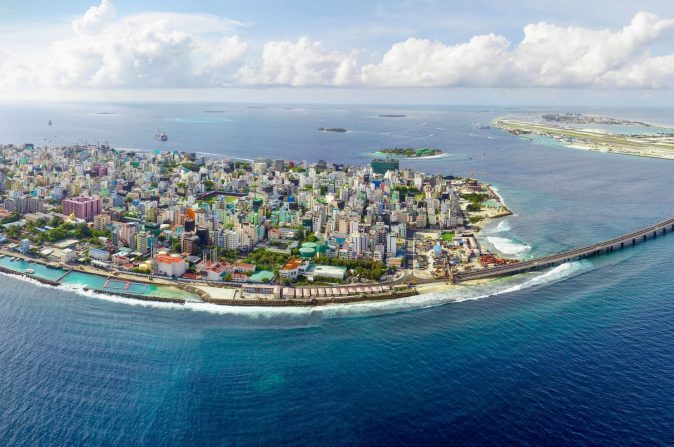Urbanism / Maldives
When an island needs to grow
For a youth with growing housing, comforts, services and connection needs, Malé has become too small.

Walking through the streets of Malé comes with the startling realization of what it means to live in a small island-turned capital city. The more the city grows, the less place there is for the individual. In the last 20 years, the population of the Maldives has nearly doubled to over 450,000. The capital Malé, and the suburb-islands of Hulhumalé and Vilingili, are home to around 46 percent of those people, even though the area accounts for just 2 percent of the country’s land mass. To be sure, only 35 of the 188 inhabited islands in the Maldives (just 19 percent) are larger than one square kilometer. Malé proper stretches to just under two kilometers. Seeking work opportunities and better public services, the Maldivian youth, better educated than ever, has flocked to the city, making it more crowded by the minute. Housing has become a luxury most can’t afford, with many employed young professionals continuing to reside with their families or living in cramped shared apartments. As we hear from one youth working as an assistant managing director at a human resources company in downtown Malé, “at this point, if I was to move out of my parents house and live on my own, rent with eat away my whole salary, before I manage to even pay the bills”. With such space limitations, it is not just housing that is scarce; gardens, parks, sports facilities, entertainment venues, are all lacking. Many young adults prefer to save their money to travel abroad, since opportunities for entertainment in the city are all but nonexistent.
The urgency of the housing problem seems well understood by the country’s leaders, as Aminath Athifa, minister of housing and urban development will attest. “The situation in the capital has become unacceptable and it affects many Maldivians. The capital currently hosts nearly half of the country’s population, with no place to expand, which means that housing prices have skyrocketed and living conditions have degraded. Today, Malé is one of the densest urban areas in the world”, she said.
Hulhumalé, a new reclaimed island-suburb of Malé, was designed to house tens of thousands of people and provide a solution for the growing demand. Since it was connected to Malé proper via the Sinamalé bridge in 2018, the island became a prefered place of living for locals. However, it will not suffice. It is already home to as many as 50,000 people, while the housing situation in the capital remains dire.
The rising prices of rent have also caught the young in a sort of housing trap. Numbeo, a platform that ranks cost of living around the world, places the average cost of rent for a one bedroom apartment in the city center between $645 and $968 per month. A three bedroom can cost up to $2,250. The average salary stands at just $630 per month. Saving for an apartment seems like an impossible endeavor, with the average cost per square meter standing at over $4,400. For landlords, the rising rents help finance new real estate purchases, further concentrating houses in the hands of the few. Social housing programs have been designed to help address the issue, but these have also been tangled in political corruption in recent years, a situation the present government has pledged to reverse.
Stalled mobility
15 times higher than London
6 times higher than Berlin
2 times higher than New York City
7% higher than Paris
Down on the avenues, an endless army of motorcycles populate the areas where people once walked. While the Maldives Transport and Contracting Company (MTCC) provides ferries for transportation between islands, there is no form of public transport on land, forcing people to resort to either the dysfunctional private taxi service or owning a motorcycle.
In 2018, there were nearly 90,000 motorcycles registered in the Maldives, the vast majority located in the capital city. The result is an intensely congested urban center with no space to expand and decreasing quality of life for its residents. To try and tackle this worsening scenario, the ministry of transport has tasked MTCC with deploying a new electric mini-bus route to reduce the use of personal vehicles. The taxi service is also under stricter regulation in an attempt to enforce improvements.
Despite all these difficulties, there is hope for the city. Hulhumalé will not be a permanent solution, but it has provided some breathing space. Land reclamation could help further ease pressure on central Malé. An improved inter-island ferry connectivity and decentralization policies aimed at integrating and developing the whole country economically, can make living in other areas much more appealing. The government has placed the issue of Malé’s congestion as one its main priorities, in a move that gives hope to the residents of this city, and the country as a whole.
